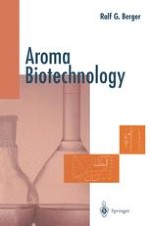1995 | OriginalPaper | Chapter
Genetically Altered Catalysts
Author : Professor Dr. Dr. Ralf G. Berger
Published in: Aroma Biotechnology
Publisher: Springer Berlin Heidelberg
Included in: Professional Book Archive
Activate our intelligent search to find suitable subject content or patents.
Select sections of text to find matching patents with Artificial Intelligence. powered by
Select sections of text to find additional relevant content using AI-assisted search. powered by
Preceding chapters have dealt with de novo syntheses, conversions and transformation reactions of substantial potential for the biotechnology of aromas. Satisfactory yields and the desired target compound(s) have, however, often not been achieved instantly. This has stimulated interest in classically mutagenized and genetically engineered strains with improved performance. The recombinant DNA technique has dramatically extended possibilities by providing a rapid means of introducing predetermined genetic alterations with high accuracy. A more rapid progress in the field is still impeded by safety considerations, public concern, and legal and administrative (partially self) restrictions. Instead of completely covering all aspects of the emotional discussion, some facts may be remembered: Gene transfer is an everyday event in nature. It was even hypothesized that bacterial transformation evolved as a nutrient uptake mechanism, because unrelated DNA is abundant in some natural environments (Redfield, 1993).Plasmid harboring cells are ecologically handicapped as compared to the wild strain. Difference in growth rates has been suggested as a diagnostic character (Park and Ryu, 1992).Safety testing of food generated with the aid of genetically manipulated strains is emphasized, particularly if the microorganisms are to remain in the consumed product.
